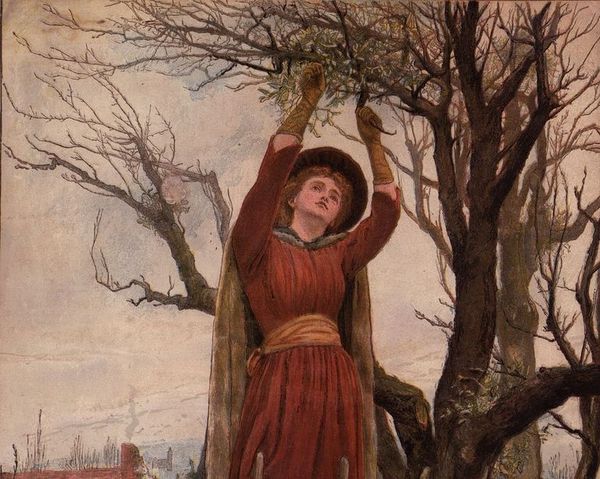Annotation:Mistletoe Bough (The): Difference between revisions
Created page with "'''Back to [[{{BASEPAGENAME}}]]''' ---- <p><font face="garamond, serif" size="4"> '''MISTLETOE BOUGH, THE'''. English, Air and Jig. F Major. Standard tuning (fiddle). AABBCC. ..." |
m Text replacement - "garamond, serif" to "sans-serif" |
||
| (5 intermediate revisions by one other user not shown) | |||
| Line 1: | Line 1: | ||
'''Back to [[{{BASEPAGENAME}}]]''' | =='''Back to [[{{BASEPAGENAME}}]]'''== | ||
---- | ---- | ||
<p><font face=" | <p><font face="sans-serif" size="4"> | ||
'''MISTLETOE BOUGH, THE'''. English, Air | '''MISTLETOE BOUGH, THE'''. English, Air (6/8 time). F Major (Trim/Hardy). Standard tuning (fiddle). AABBCC. "The Mistletoe Bough" is a ballad [http://en.wikipedia.org/wiki/Legend_of_the_Mistletoe_Bough] from c. 1830, by Thomas Haynes Bayley and Sir Henry Bishop, supposedly inspired by an event that occurred at Exton Hall, Rutland. One version of the story goes that Catherine Noel, the 18 year old daughter of the owner, hid in a large chest during a game of hide-and-seek. Unfortunately, she was unable to get the lid open and suffocated. In another version it is a newlywed bride who accidentally locks herself in the trunk and is not found until years later, in a much decayed state. Either way, the story was not new. In fact, Bayly was reportedly inspired by "Ginevra", from '''Italy, a Poem''' (1822) by Samuel Rogers. The story has entered "urban myth" status and versions are still told today.[[File:mistletoebough.jpg|600px|thumb|right|]] | ||
<blockquote> | <blockquote> | ||
''The mistletoe hung in the castle hall''<br> | ''The mistletoe hung in the castle hall''<br> | ||
| Line 16: | Line 16: | ||
''Oh, the mistletoe bough.''<br> | ''Oh, the mistletoe bough.''<br> | ||
</blockquote> | </blockquote> | ||
The ballad was quite popular in Victorian times. | |||
</font></p> | </font></p> | ||
<p><font face=" | <p><font face="sans-serif" size="4"> | ||
''Source for notated version'': | ''Source for notated version'': | ||
<br> | <br> | ||
<br> | <br> | ||
</font></p> | </font></p> | ||
<p><font face=" | <p><font face="sans-serif" size="4"> | ||
''Printed sources'': Trim ('''Thomas Hardy'''), 1990; No. 30. | ''Printed sources'': Trim ('''Thomas Hardy'''), 1990; No. 30. | ||
<br> | <br> | ||
<br> | <br> | ||
</font></p> | </font></p> | ||
<p><font face=" | <p><font face="sans-serif" size="4"> | ||
''Recorded sources'': <font color=teal></font> | ''Recorded sources'': <font color=teal></font> | ||
</font></p> | </font></p> | ||
| Line 33: | Line 34: | ||
<br> | <br> | ||
---- | ---- | ||
'''Back to [[{{BASEPAGENAME}}]]''' | =='''Back to [[{{BASEPAGENAME}}]]'''== | ||
Latest revision as of 14:24, 6 May 2019
Back to Mistletoe Bough (The)
MISTLETOE BOUGH, THE. English, Air (6/8 time). F Major (Trim/Hardy). Standard tuning (fiddle). AABBCC. "The Mistletoe Bough" is a ballad [1] from c. 1830, by Thomas Haynes Bayley and Sir Henry Bishop, supposedly inspired by an event that occurred at Exton Hall, Rutland. One version of the story goes that Catherine Noel, the 18 year old daughter of the owner, hid in a large chest during a game of hide-and-seek. Unfortunately, she was unable to get the lid open and suffocated. In another version it is a newlywed bride who accidentally locks herself in the trunk and is not found until years later, in a much decayed state. Either way, the story was not new. In fact, Bayly was reportedly inspired by "Ginevra", from Italy, a Poem (1822) by Samuel Rogers. The story has entered "urban myth" status and versions are still told today.

The mistletoe hung in the castle hall
The holly branch shone on the old oak wall.
The Baron's retainers were blithe and gay,
Keeping the Christmas holiday.
The Baron beheld with a father's pride
His beautiful child, Lord Lovell's bride.
And she, with her bright eyes seemed to be
The star of that goodly company.
Oh, the mistletoe bough.
Oh, the mistletoe bough.
The ballad was quite popular in Victorian times.
Source for notated version:
Printed sources: Trim (Thomas Hardy), 1990; No. 30.
Recorded sources:
